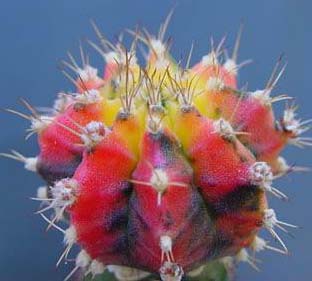ON THE NAMES OF CULTIVARS
Anatoly Mikhaltsov
Chairman of the "Aztekium" C&S club, Omsk, Russia
Translated from Russian by Larisa Zaitseva

Photo 2. Gymnocalycium mihanovichii Black Red Cap. |
Hobbyists buying colored cacti cultivars in the shops have usually a lot of questions about their names as the companies trading in cultivars sell them under different names or as often as not without any names at all. For many years the European floricultural market has been literally flooded by the so-called "Dutch" colored forms of Gymnocalycium. As it happens the major part of these plants comes from South Korea. A floricultural company "Cheong Poong Floriculture Corp." since 1978 brings plenty of colored cacti to the markets of Holland, USA, Australia, Canada, Japan, Brazil and other countries. No wonder these attractive plants made their way into collections of our hobbyists under different names. And even now the colored forms of cacti are sold without any cultivar names.
But why haven't these cacti got labels attached to them so far? And how are we, hobbyists to call them? I think it's possible to keep the names assigned to them by the trading companies. Price lists of the companies dealing with the colored forms of cacti abound in such "names" as, for example, Pink Cap, Yellow Cap, Violet Cap, Black Cap and so on (Photo 1). You've only got to bear in mind that these designations are not cultivar names, they do not comply with the articles of the International Code of Nomenclature for Cultivated Plants (ICNCP): the epithets are not written within single quotation marks, it's unclear whether the name is valid or not, the originators of these plants are not mentioned either. In short these designations are only commercial names. According to the article 8 of the ICNCP (1995) the usage of commercial names instead of cultivar epithets is not supported by this code, and commercial names can't be accepted as cultivar epithets. Though there are some of the colored cacti forms that were distributed by certain companies with cultivar names.

Photo 5. Gymnocalycium mihanovichii 'Nishiki'. |
What are the cacti fanciers to do? I think in such cases it would be prudent to contact the trading companies and find out the cultivar names. In Photo 2 you may see a variegated Gymnocalycium friedrichii which very quickly spread through the collection of Russian hobbyists under the name 'Dracula'. But when we got hold of the catalogue of a South Korea company we noticed that the same plant had commercial name Gymnocalycium Black-Rubra. How are we to call this plant then? I may only advise to stick to the names given by the trading company and not to forget that these names are only commercial ones.
The Photos 3-5 picturing widely spread colored Gymnocalycium cultivars are shown here so you may make out at least their commercial names. We do not stop hoping that the companies producing colored cultivars will begin registering their plants officially at last.
The Photos 6, 7 picture cultivars which had labels with cultivar names, and I think it's fitting to show them here so you may know their accepted names. Though try as we might we couldn't find out the body which registered those cultivars. It's quite probable that they were not registered at all and the names were not published either…
Sometimes the plants are sold without species names, only with commercial names. I take the liberty to remind you that the name of any species consists of two parts, the genus name and the species name. I know of cases when cultivars were sold only with genus name. Though it's quite probable that these plants were poly-hybrids and it was impossible to determine their true species.
Some companies are altogether indifferent to the species names, their major goal is to increase sales volume. Perhaps you have already noticed that many colored cacti forms are of hybrid origin and offered without names in the shops. I'd like to make a warning that it would be unwise to give names to the imported colored forms of cacti by yourself so as not to build up further confusion. Many colored cacti with red-colored stem from Gymnocalycium mihanovichii group are very much alike, for this reason they were given the name of cultivar group in accordance with the requirements of ICNCP, Gymnocalycium mihanovichii gr. 'Japan Rood'.





